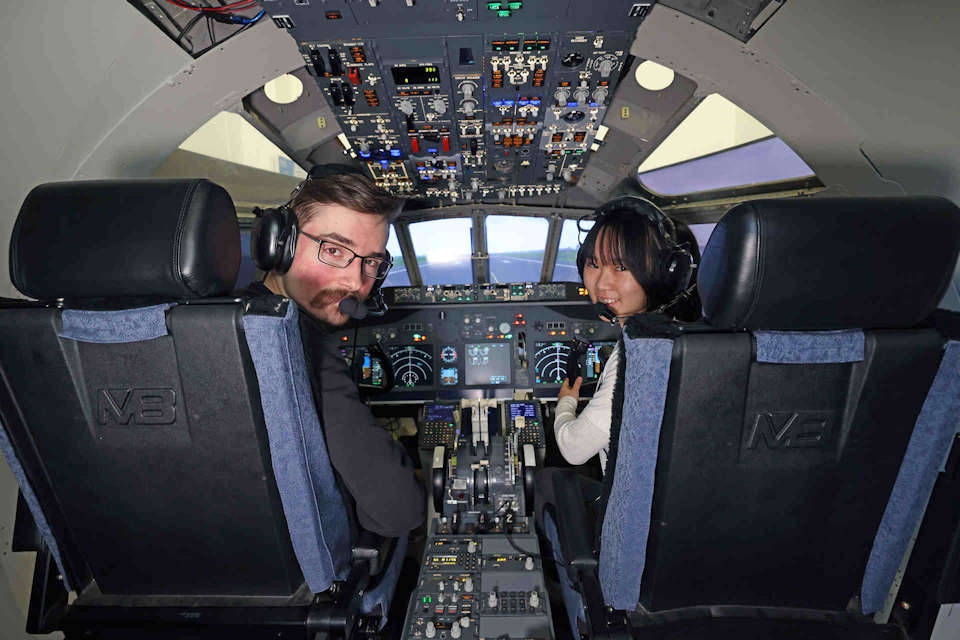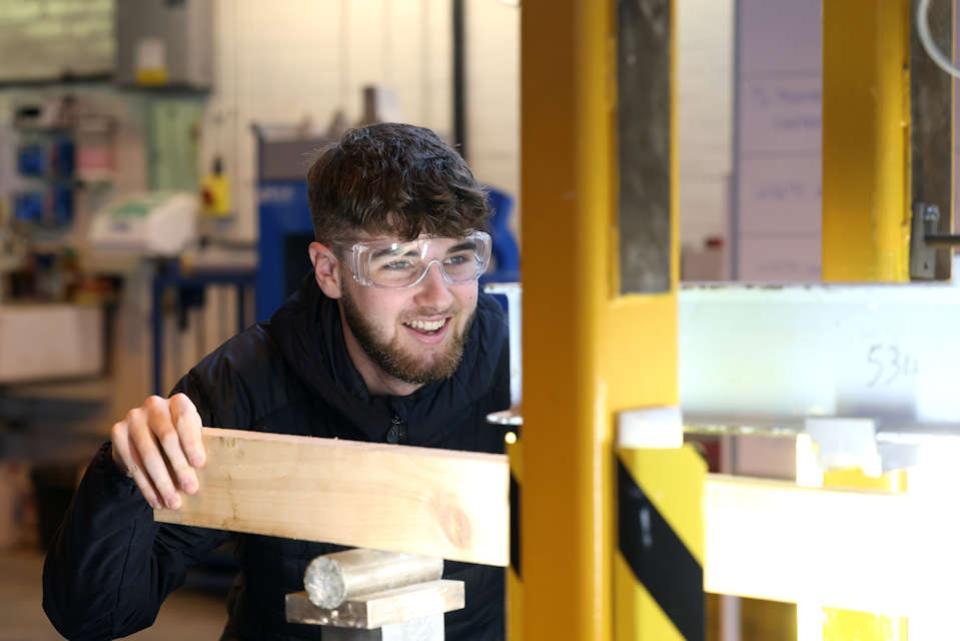Facilities
Our world-class, modern engineering teaching, learning and research facilities are designed to support the distinctive way engineering students engage with their learning process through design-make-test activities.
The School's impressive specialist engineering research laboratories and research facilities also provide the setting for practical work and student projects.
Design Studio
The Design Studio is a space designated for our Product Design Engineering students to cultivate a studio culture where teams of design engineers meet, work, study, discuss projects with their supervisors and showcase their work.
The studio is equipped with a Materials Library, Design photography equipment, model making materials, desk space and specialist design computers. It also hosts the annual Design Show, where our graduating students show off their final projects, encompassing everything from sustainable fast furniture solutions to therapeutic lamps for those with neurodivergence, and exoskeleton wearables for those living with neuromuscular conditions.
reduced,for,web-960.jpg)
Active Learning Labs
We are home to Europe's premier engineering Active Learning Laboratories. They include two floors of flexible laboratory and design teaching space, used exclusively by our undergraduate and postgraduate engineering students. They also contain our manufacturing robots and rapid prototyping teaching facilities. It's an excellent place for engineering students to develope their practical and design skills, as well as to collaborate and network.
They provide you with everything you need to test, refine and make your ideas a reality. Large open spaces for group work, brainstorming and presenting. Workshops for woodworking, heat pressing, laser cutting, 3D printing, and pretty much anything else you can think of. In addition to the technological resources, the Active Learning Lab uses a student-centred approach to education, encouraging active participation and teamwork. The labs are designed to facilitate project-based learning, where students work in groups on projects that mirror the complexities and dynamics of professional engineering practice. Our dedicated technicians are always on hand to offer support and share their valuable know-how.
_960.jpg)
Flight Simulators
We’re proud of our strength in this area. While quite a few universities have flight simulators, Liverpool is internationally renowned for its simulators for both research and teaching.
We make significant contributions to international flight simulation activities. Rather than replicating a particular aircraft model, we can simulate a variety of aircraft, and even space craft. This opens up a lot more possibilities for our teaching and research, whether it is a space shuttle project or our Royal Aeronautical Society Flight Simulation medal wins.
Working on a set of standards to enable aircraft certification through simulation, rather than actual flight, our research aims to reduce aircraft programme costs and environmental impact. Our flight simulation research is also having award winning industrial impact on aircraft safety clearances to ships.
We also have our student led flight simulators which house simulators for basic flight training (PA-38 Tomahawk) through to commercial aircraft (Jetstream 41 and Boeing 737) and fast jet trainers. It’s a popular spot for our aerospace students, particularly those interested in becoming pilots.

Hydraulics Lab
90,000 litres of water. Almost 4 metres long. Flow speeds of 6 metres per second. Our biggest water channel doesn’t do things by halves. One of its many uses has been to model flow over the Royal Navy’s largest ever ship class, the Queen Elizabeth Class aircraft carriers. The data, integrated into a flight simulator, allows pilots to safely practice landing on the ship in the highly unsteady wind conditions.
Elsewhere we have two flumes capable of recirculating water with suspended sediment, one of which is also equipped with a wavemaker. The lab also contains a 1 metre wide wave tank and a GeoTank facility. This equipment is used for projects ranging from evaluating nature-based solutions for flood mitigation and coastal defence to the environmental impacts of offshore energy projects. We are also able to characterise the dynamics and changes in particle flow using laser bed scanning, Acoustic Doppler Velocimetry, and Particle Image Velocimetry (PIV) systems. This includes state of the art Dantec Dynamics equipment capable of two-dimension three component PIV, laser-induced fluorescence, and volumetric velocimetry techniques.

Materials and Structural Laboratory
This multi-functional laboratory is at the heart of our Department of Civil and Environmental engineering teaching and research.
It includes dedicated areas for testing and optimising, through evidence-based approaches, sustainable and resilient structural engineering solutions for buildings and other civil infrastructure, from the nanoscale material level to full systems.
Students work on projects ranging from low carbon solutions made from waste, recycled materials and natural fibres to innovative infrastructure designs.
Using our advanced and unique testing facilities we analyse the combined effects of environmental and mechanical factors, such as ageing, earthquakes and climate change, on structural engineering materials and infrastructure. High-resolution measurement technologies monitor the static and dynamic response of structural materials, components and systems. Testing under extreme conditions, we design and test resilient modular buildings that can rise upwards above floodwaters or respond elastically during earthquakes to reduce damage.

Biomedical Engineering labs
We have developed an array of multi-disciplinary labs and facilities which support our world leading research in Biomedical engineering. The labs have been specifically designed to support the design and development of novel biomaterials and testing with in-house microbiology and tissue culture facilities. This activity is supported by the latest 3D printers (including bioprinters), and electro spinners. We also host an imaging suite which supports fluorescent and confocal microscopy and desktop SEMs, as well as enhanced material and tissue characterisation with Atomic Force Microscopes and Nanoindentors. The facilities support the pipeline from conception, materials and biological testing through to translation of novel materials and therapies for a range of clinical applications.

Additive Manufacturing labs
Supporting our pioneering additive manufacturing research and teaching, our lab includes state-of the-art metal 3D printers and instruments ranging from in-house developed test-rigs (process monitoring, laser processing) to industrial-grade machines (TRUMPF TruPrint1000, Renishaw AM 250, Arcam A1 EBM). Our team translates research into teaching projects to allow students to gain experience on 3D lattice design, topology optimisation and new machine prototype development.

Digital Innovation Facility
Just a few minutes’ walk from the engineering buildings, the Digitial Innovation Facility was established to bridge the innovation gap between academic research and new product and process development. One of the UK’s leading digital engineering impact centres, it is used for a wide variety of our teaching and research. Our aerospace students find out whether their drone designs pass the flying test in the Extreme Environment Lab. Advanced robotics in the smARTlab helps us evolve health tech and digital solutions to global challenges, such as clean energy, are tested using the digital twin and advanced visualisation equipment in the Mixed Reality Laboratory.
Ness Botanic Gardens
Bequeathed to the university in 1948, Ness Botanic Gardens now spans 64 acres of plants and wildlife. Open to the public, it also has an important role in education and research. One example is our solar powered chiller project. After building and testing a prototype cargo container chiller at Ness Gardens, students travelled to Zanzibar to share their findings. The hope is that the refrigerated containers will provide the island with a cheap, accessible and sustainable way to store food and prevent waste.
Albert Crewe Centre for Electron Microscopy
The Albert Crewe Centre advances new methods in electron microscopy and challenges the limits of spatial, temporal and energy resolution. It is particularly useful for looking at morphology, microstructure and chemical composition. Using integrated AI to design, implement and interpret atomic scale measurements, things get technical pretty quickly with this equipment. Suffice to say there is some powerful technology here – from ultra high-resolution microscopes to controlled liquid and gas environments for sample testing.